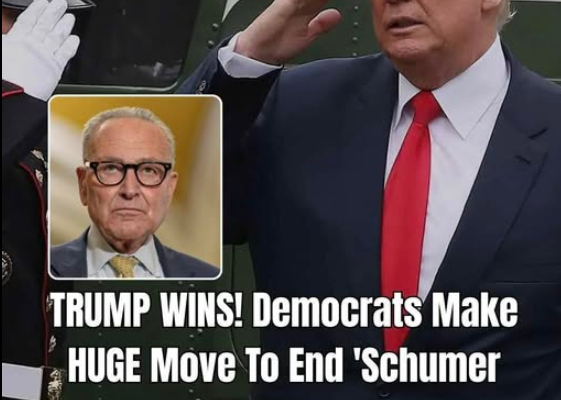The Democratic Party finds itself under intense pressure as a government shutdown led by Senate Majority Leader Chuck Schumer stretches toward its one-month mark. What began as a high-stakes political standoff over federal spending and key policy priorities has evolved into a test of leadership, unity, and endurance within the party. Each passing day brings new consequences—furloughed workers, delayed paychecks, halted services—and with them, mounting frustration from the American public. As voters grow increasingly weary, Democrats are struggling to contain the political fallout and manage divisions that threaten to fracture their ranks.
The shutdown began as a dispute over the latest spending bill, with Democrats insisting on including provisions addressing issues such as healthcare funding, social safety nets, and environmental protections. Republicans, meanwhile, pushed for a “clean” continuing resolution—one that would keep the government open without adding new spending initiatives or policy riders. Schumer’s refusal to support a version of the bill that did not include Democratic priorities set off a cascade of deadlock in the Senate. Now, weeks later, the effects are being felt nationwide, and the narrative has begun to shift against the Democrats.
For Schumer, the situation represents one of the most significant tests of his political career. As Senate Majority Leader, he carries the responsibility of uniting a caucus that is far from monolithic. Progressive members demand that the shutdown serve as leverage for achieving long-promised reforms, while moderates warn that prolonging the standoff could alienate swing voters and damage the party’s image as the voice of responsible governance. Schumer’s balancing act has become increasingly precarious, as both factions grow impatient with the lack of results.
Inside the Senate, the political maneuvering has become intense. Republicans accuse Democrats of playing politics with people’s livelihoods, pointing to hundreds of thousands of federal employees who have gone weeks without pay. Some GOP leaders have gone so far as to accuse Schumer of using ordinary Americans as bargaining chips in a broader political game. Democrats counter that Republicans could end the shutdown immediately by agreeing to negotiate in good faith on funding priorities that reflect the needs of working families. Yet, as the rhetoric escalates, compromise feels ever more elusive.
Public opinion has begun to tilt uncomfortably for the Democrats. In the first week of the shutdown, most polls showed the public evenly divided over which party was to blame. By the third week, however, cracks started to appear. Reports of unpaid air traffic controllers, delayed Social Security checks, and shuttered federal parks have dominated news coverage, fueling public anger. Many Americans no longer care who is right—they just want the government to function again. That sentiment has translated into growing criticism of both parties, but Democrats, who control the Senate and the White House, are increasingly seen as the ones who must find a way out.
The longer the shutdown lasts, the harder it becomes for Schumer to defend the Democratic position. He insists that the party is standing firm on principle, fighting for a fairer budget that doesn’t leave behind the middle class. But each day the government remains closed, that message risks being drowned out by stories of struggling families and unpaid workers. The White House, for its part, has sought to project calm, emphasizing that negotiations are ongoing. Still, the political costs are beginning to mount, and even some Democratic strategists privately worry that the party may have miscalculated.
Internally, Democratic unity is fraying. Moderate senators from battleground states are quietly urging Schumer to strike a deal before the damage becomes irreversible. They fear that the longer the shutdown drags on, the more it will erode their chances in upcoming elections. Progressive lawmakers, on the other hand, argue that conceding too soon would waste a rare opportunity to extract meaningful policy gains. The result is a deepening split between pragmatism and idealism, with Schumer caught in the middle, struggling to appease both wings of his party while keeping negotiations alive with Republicans.
The economic toll of the shutdown is also adding pressure. Each week of government closure is estimated to shave billions off the economy, with ripple effects reaching from federal contractors to local businesses dependent on government spending. Consumer confidence has dipped, financial markets have grown jittery, and economists warn that a prolonged impasse could lead to longer-term economic harm. These warnings have not been lost on voters, who increasingly view the shutdown as a failure of leadership on both sides.
Behind the scenes, efforts to broker a deal continue. Bipartisan meetings have been held, and proposals have circulated that would reopen the government temporarily while talks continue on broader policy disputes. Some senators have floated a short-term funding bill that would keep the government open for thirty days while a commission works on longer-term spending solutions. Yet progress has been slow, and trust between the parties remains thin. Both sides fear appearing weak, and both are aware that the first to blink could lose political leverage.
For Schumer, the challenge is not only negotiating an end to the shutdown but also managing its political consequences. His leadership style—methodical, cautious, and consensus-driven—has served him well in the past, but in this crisis, it has drawn criticism from those who believe he has not acted decisively enough. Allies argue that he is playing a long game, protecting Democratic priorities while allowing pressure to build on Republicans. Critics, however, contend that the party is losing the battle of perception, appearing more focused on politics than on the pain being felt by everyday Americans.
The coming days will be crucial. If a deal is reached soon, Schumer could frame the outcome as a victory for responsible governance and Democratic values. If the shutdown continues into a second month, the narrative could shift decisively against him and his party. Already, some political commentators have begun to draw parallels to past shutdowns that damaged the party perceived as obstructing progress. The stakes, both politically and economically, could not be higher.
Ultimately, the shutdown has become about more than just funding bills or budget lines—it is a reflection of a broader struggle over the direction of the Democratic Party and the nature of leadership in a deeply divided political landscape. Schumer’s challenge is to navigate between principle and pragmatism, to show strength without appearing inflexible, and to find a way to reopen the government without surrendering the party’s core values. Whether he can achieve that balance will determine not only his legacy as a leader but also the political fortunes of his party in the months ahead.
For now, Washington remains at a standstill. Federal workers wait anxiously for paychecks that may not come. Families dependent on government programs face uncertainty. The public’s patience is wearing thin. As the shutdown nears the end of its first month, the sense of urgency grows stronger. Schumer and his fellow Democrats know that time is running out—not just to end the shutdown, but to convince Americans that they are capable of governing effectively when it matters most.


